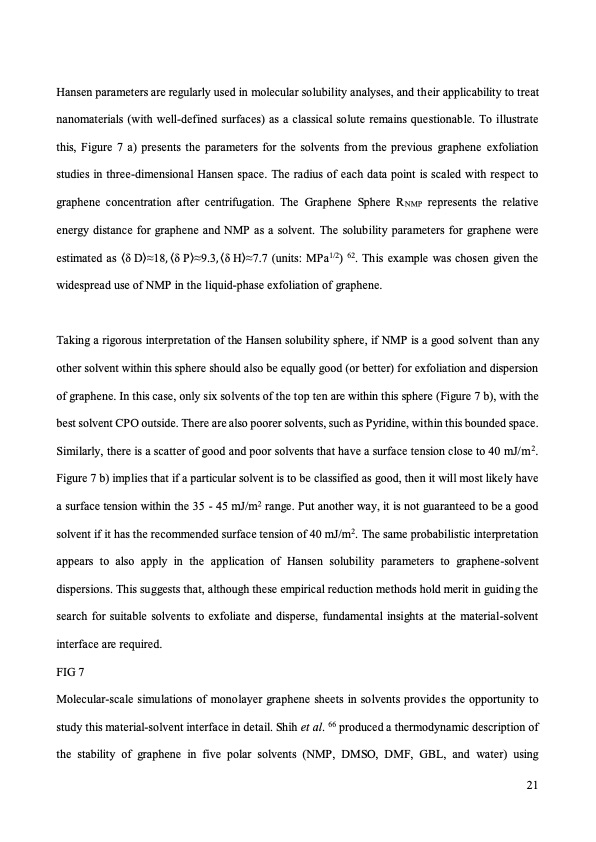
PDF Publication Title:
Text from PDF Page: 021
Hansen parameters are regularly used in molecular solubility analyses, and their applicability to treat nanomaterials (with well-defined surfaces) as a classical solute remains questionable. To illustrate this, Figure 7 a) presents the parameters for the solvents from the previous graphene exfoliation studies in three-dimensional Hansen space. The radius of each data point is scaled with respect to graphene concentration after centrifugation. The Graphene Sphere RNMP represents the relative energy distance for graphene and NMP as a solvent. The solubility parameters for graphene were estimated as 〈δ D〉≈18, 〈δ P〉≈9.3, 〈δ H〉≈7.7 (units: MPa1/2) 62. This example was chosen given the widespread use of NMP in the liquid-phase exfoliation of graphene. Taking a rigorous interpretation of the Hansen solubility sphere, if NMP is a good solvent than any other solvent within this sphere should also be equally good (or better) for exfoliation and dispersion of graphene. In this case, only six solvents of the top ten are within this sphere (Figure 7 b), with the best solvent CPO outside. There are also poorer solvents, such as Pyridine, within this bounded space. Similarly, there is a scatter of good and poor solvents that have a surface tension close to 40 mJ/m2. Figure 7 b) implies that if a particular solvent is to be classified as good, then it will most likely have a surface tension within the 35 - 45 mJ/m2 range. Put another way, it is not guaranteed to be a good solvent if it has the recommended surface tension of 40 mJ/m2. The same probabilistic interpretation appears to also apply in the application of Hansen solubility parameters to graphene-solvent dispersions. This suggests that, although these empirical reduction methods hold merit in guiding the search for suitable solvents to exfoliate and disperse, fundamental insights at the material-solvent interface are required. FIG 7 Molecular-scale simulations of monolayer graphene sheets in solvents provides the opportunity to study this material-solvent interface in detail. Shih et al. 66 produced a thermodynamic description of the stability of graphene in five polar solvents (NMP, DMSO, DMF, GBL, and water) using 21PDF Image | graphene production via nonoxidizing liquid exfoliation

PDF Search Title:
graphene production via nonoxidizing liquid exfoliationOriginal File Name Searched:
Graphene-R2-review.pdfDIY PDF Search: Google It | Yahoo | Bing
Salgenx Redox Flow Battery Technology: Power up your energy storage game with Salgenx Salt Water Battery. With its advanced technology, the flow battery provides reliable, scalable, and sustainable energy storage for utility-scale projects. Upgrade to a Salgenx flow battery today and take control of your energy future.
| CONTACT TEL: 608-238-6001 Email: greg@infinityturbine.com | RSS | AMP |